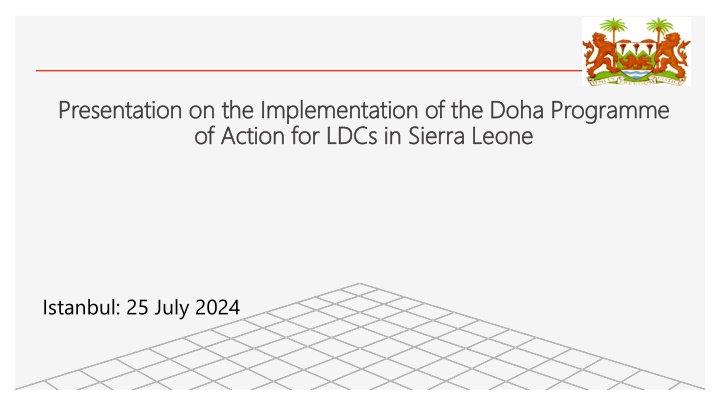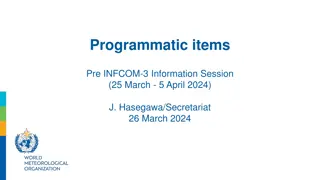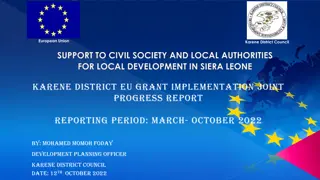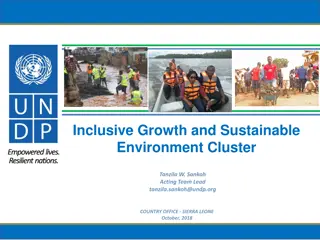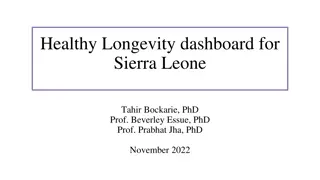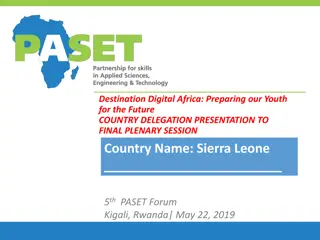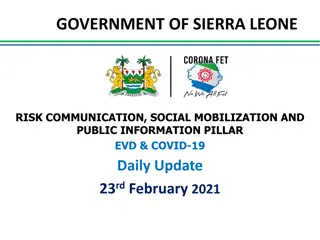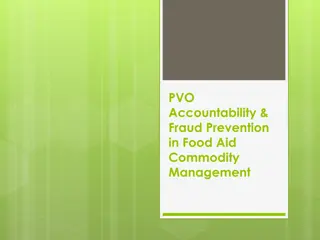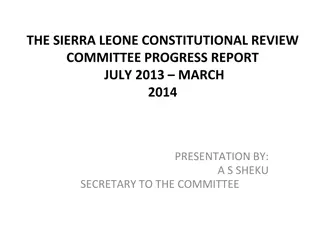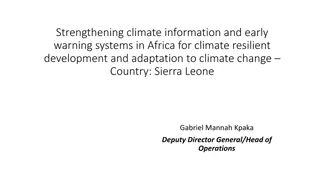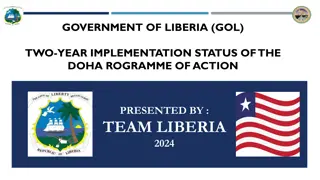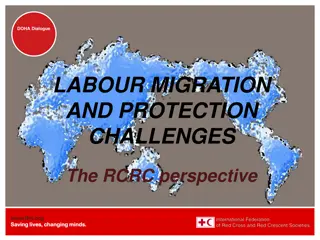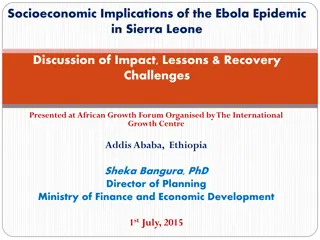Implementation of Doha Programme in Sierra Leone
Sierra Leone has successfully integrated the Doha Programme of Action for Least Developed Countries into its national development plans. The country's Medium-Term National Development Plan 2024-2030 aligns with global agendas such as the 2030 Agenda for Sustainable Development and focuses on key areas like diversifying the economy, governance, climate resilience, gender mainstreaming, and financing partnerships. The plan aims to achieve middle-income status by 2039.
Download Presentation

Please find below an Image/Link to download the presentation.
The content on the website is provided AS IS for your information and personal use only. It may not be sold, licensed, or shared on other websites without obtaining consent from the author.If you encounter any issues during the download, it is possible that the publisher has removed the file from their server.
You are allowed to download the files provided on this website for personal or commercial use, subject to the condition that they are used lawfully. All files are the property of their respective owners.
The content on the website is provided AS IS for your information and personal use only. It may not be sold, licensed, or shared on other websites without obtaining consent from the author.
E N D
Presentation Transcript
Presentation on the Implementation of the Doha Programme Presentation on the Implementation of the Doha Programme of Action for LDCs in Sierra Leone of Action for LDCs in Sierra Leone Istanbul: 25 July 2024
Outline of Presentation Implementation of the DPoA Overview Integrating the DPoA in National Plans Status of implementation of the DPoA in Sierra Leone Challenges Suggestions for structured support in the implementation
Overview Sierra Leone has integrated the LDC programmes of Action in its national development plans over the years. DPoA implementation commenced at the tail end of the implementation of the National Plan, the MTNDP (2019-2023). However, the eight policy clusters of the MTNDP (2019-2023) were well aligned with the SDGs , which the six priority areas of the DPoA re-enforces. A successor National Development Plan, the Medium-Term National Development Plan 2024-2030 (MTNDP 2024-2030) and is aligned to the regional and global agendas such as the 2030 Agenda for Sustainable Development, the DPoA and the AU Agenda 2063. The Plan is a seven-year plan to ensure that its implementation period aligns with the end date of the 2030 Agenda. The Plan also has the objective of the country achieving middle income status by 2039
Integrating the DPoA in National Plans The SL MTNDP 2024-2030 The Big 5 game changers Enabler 1: Diversifying the economy & promoting growth Enabler 2: Governance and accountability Enabler 3: Advancing climate resilience & environmental actions Enabler 4: Gender mainstreaming Enabler 5: Financing, partnerships for implementation & risk management
Linkages between the Big 5s, SDGS and the DPoA The SL MTNDP Big 5s SDGs DPoA Focus Areas Feed Salone SDGs 1, 2, 12 14 and 15 Focus Areas 1, 5 Human Capital Development SDGs 3, 4, 6 and 11 Focus Areas 1, 3 Youth Employment Scheme SDGs 4, 8 and 10 Focus Areas 1, 2, 3 Technology Infrastructure SDGs 7, 9, 11 and 17 Focus Area 3, 4, 6 Transforming the Public Sector Architecture SDGs 4 and 16 Focus Areas 1, 3
Status of Implementation The Big Five Game Changers (Big 5s) and Enablers aim at delivering not only the national development agenda but also meeting regional and international development goals and targets as contained in the SDGs and DPoA. On the DPoA focus area 1, Investing in People, the new MTNDP has youth employment as one of its priority areas. The Technology and Infrastructure Big 5 is geared towards leveraging the power of science and technology to promote sustainable development. The UN has been providing support for technological advancement through various initiatives, including the UNDP s accelerator lab. In the area of structural transformation, the UNCT and other development partners are supporting efforts at diversifying the economy by, moving from traditional processes to more technologically based processes in agriculture, fisheries, mining, tourism etc. On trade, Sierra Leone is seeking to leverage the opportunities offered by the African Continental Free Trade Agreement (AfCFTA) to trigger economic growth. There is the active support of the UNCT and other development partners in preparation of the MTNDP and its implementation for the attainment of the SDGs and DPoA commitments, through alignment of their country strategies to the national plan. The new UN Cooperation Framework for Sierra Leone has fully integrated the Big 5s.
Status of Implementation Contd Advancing climate resilience and environmental action is one of the enablers of the new MTDNP. The UNCT in collaboration with other development partners are fully engaged in discussions around climate change vulnerabilities and mitigation measures for the country. Moreover, the UN supported the country in developing a Nationally Determined Contribution (NDC) as well supporting participation of the Sierra Leone delegation to COP 28 UAE. The enactment of the GEWE policy for promoting gender equality in various spheres of life. This has resulted in increases in female representation in Parliament and ministerial appointments.
Status of Implementation Contd In order to strengthen monitoring and reporting, a National Monitoring and Evaluation Agency NAMEA has been established. National Monitoring and Information System (NaMEMIS) which is an integrated online M&E system for the Sierra Leone Government and donor partner funded projects, programmes and policies. It is yet at its early stages and needs to be fully operationalised. Evaluation Management
Experiences a. National Ownership is crucial. This requires a whole government and whole of society approach. b. Inclusivity multi stakeholders' consultations are the hall mark of the Plan preparation from which the plan priorities were derived and linking these national priorities with international agreements, such as the DPoA. The actions areas of the DPoA were reviewed by the people during the consultations to determine their relevance at district/regional and national level going forward c. Coordination with development actors - working closely with the UN country team and development partners to ensure alignment and ensure that partners are mobilised and committed to supporting the localization of the DPoA. Development dialogue through the DEPAC, the DDCCs and CDCs have proven very useful d. Tracking of ODA through the Development Assistance Database has helped in identifying underserved areas
Challenges External risks such as the poly crises and its domino effect on LDCs such as Sierra Leone Impact of National Disasters e.g the heavy rains and flooding experienced in recent days Ability to finance development programme as a result of very tight fiscal space. The country s debt burden continues to crowd out social expenditure. Capacity constrained Statistical and M&E systems that impacts monitoring and reporting The Monitoring and Evaluation Framework is still work in progress due to capacity constraints and paucity of data, especially baseline data
Recommendations 1. Debt suspension initiatives to create the fiscal space 2. National dialogue that ensures that no one is left behind 3. Investing in the capacity of National Statistical and M&E systems for effective monitoring and reporting. 4. Strengthening coordination mechanisms at both the national and sub national levels 5. Increased efforts at mobilizing resources at the national level using the INFF as well as at the global level. 6. Increase the visibility of the DPoA through DPoA specific support to the country level
Thank You! Tenki!
